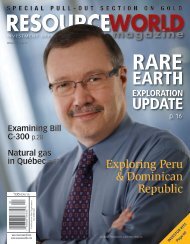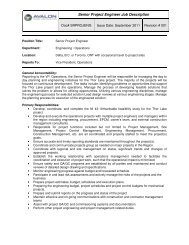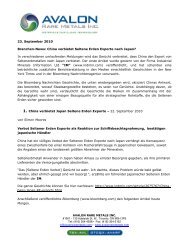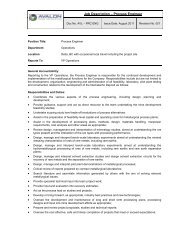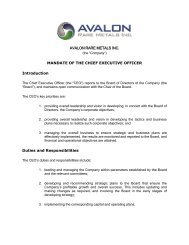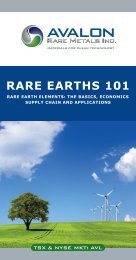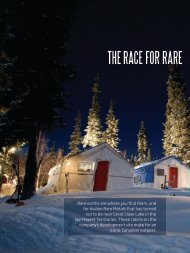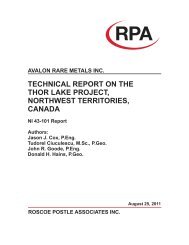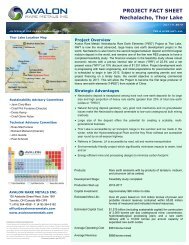technical report on the nechalacho deposit, thor lake project ...
technical report on the nechalacho deposit, thor lake project ...
technical report on the nechalacho deposit, thor lake project ...
Create successful ePaper yourself
Turn your PDF publications into a flip-book with our unique Google optimized e-Paper software.
Vegetati<strong>on</strong><br />
Vegetati<strong>on</strong> mapping of <strong>the</strong> general Pine Point area was first undertaken in 1977 by BC<br />
Research using black and white aerial photographs and fieldwork. Mapping of <strong>the</strong> area was<br />
carried out again using aerial photographs taken in June 1979 by Beak C<strong>on</strong>sultants Ltd. The<br />
plant communities identified from <strong>the</strong>se studies were: jack pine, aspen, mixed jack pine/black<br />
spruce, white spruce, black spruce, shrub, fen, muskeg and burn, for a total of nine distinct<br />
types.<br />
In September 2005, EBA collected new baseline vegetati<strong>on</strong> and ecosystem data for <strong>the</strong><br />
proposed Tamerlane Pilot Project Regi<strong>on</strong>al Study area located immediately to <strong>the</strong> west of <strong>the</strong><br />
current area of interest.<br />
Eight naturally vegetated ecosystem units were classified within <strong>the</strong> Pine Point Regi<strong>on</strong>al Study<br />
Area. The most comm<strong>on</strong> ecosystem was <strong>the</strong> upland, Labrador Tea – Mesic ecosite (28.3 %).<br />
The Shrubby and Treed fens, characteristic of lowland landforms, were sec<strong>on</strong>d and third in area<br />
(24.6 % and 24.3 %) (EBA 2005a).<br />
Based <strong>on</strong> <strong>the</strong> informati<strong>on</strong> <str<strong>on</strong>g>report</str<strong>on</strong>g>ed in EBA 2005a and our understanding that <strong>the</strong> area of interest<br />
to <strong>the</strong> north of <strong>the</strong> former Pine Point Mine c<strong>on</strong>sists primarily of lowland landforms draining<br />
towards Great Slave Lake, wetland ecosystems dominate <strong>the</strong> land in this area.<br />
The main wetland ecosystems present in <strong>the</strong> area of interest include Graminoid, Shrubby and<br />
Treed Fen ecosites. The fens are generally restricted to areas of poorly drained organic soils.<br />
Soils tend to be rich in nutrients. Stand compositi<strong>on</strong> in <strong>the</strong> regi<strong>on</strong> varies due to <strong>the</strong> fire regime.<br />
Early successi<strong>on</strong>al stands are dominated by an open canopy of bog birch, while mature stands<br />
have a closed canopy of black spruce and larch.<br />
The limited upland landforms in <strong>the</strong> area of interest include Bearberry Pj, Canada Buffalo –<br />
Green Alder, Labrador Tea – Mesic, and Labrador Tea – Subhygric ecosites. They are<br />
dominated by jack pine, aspen and paper birch in seral communities, and black and white<br />
spruce in climax communities. Immediately after fire, <strong>the</strong> communities are dominated by fast<br />
growing deciduous seral species such as paper birch and alder (Alnus species). The slower<br />
growing jack pine becomes <strong>the</strong> dominant species a few years after fire.<br />
To c<strong>on</strong>firm that <strong>the</strong> vegetati<strong>on</strong> cover present in <strong>the</strong> area of interest is as described herein, it is<br />
recommended that an appropriate field study be undertaken during <strong>the</strong> early summer of 2010.<br />
This study could be undertaken in c<strong>on</strong>juncti<strong>on</strong> with an equally necessary wildlife and wildlife<br />
habitat study.<br />
Technical Report 43-101 – March 13, 2011 Page 18-103<br />
Prepared by Aval<strong>on</strong> Rare Metals Inc.





